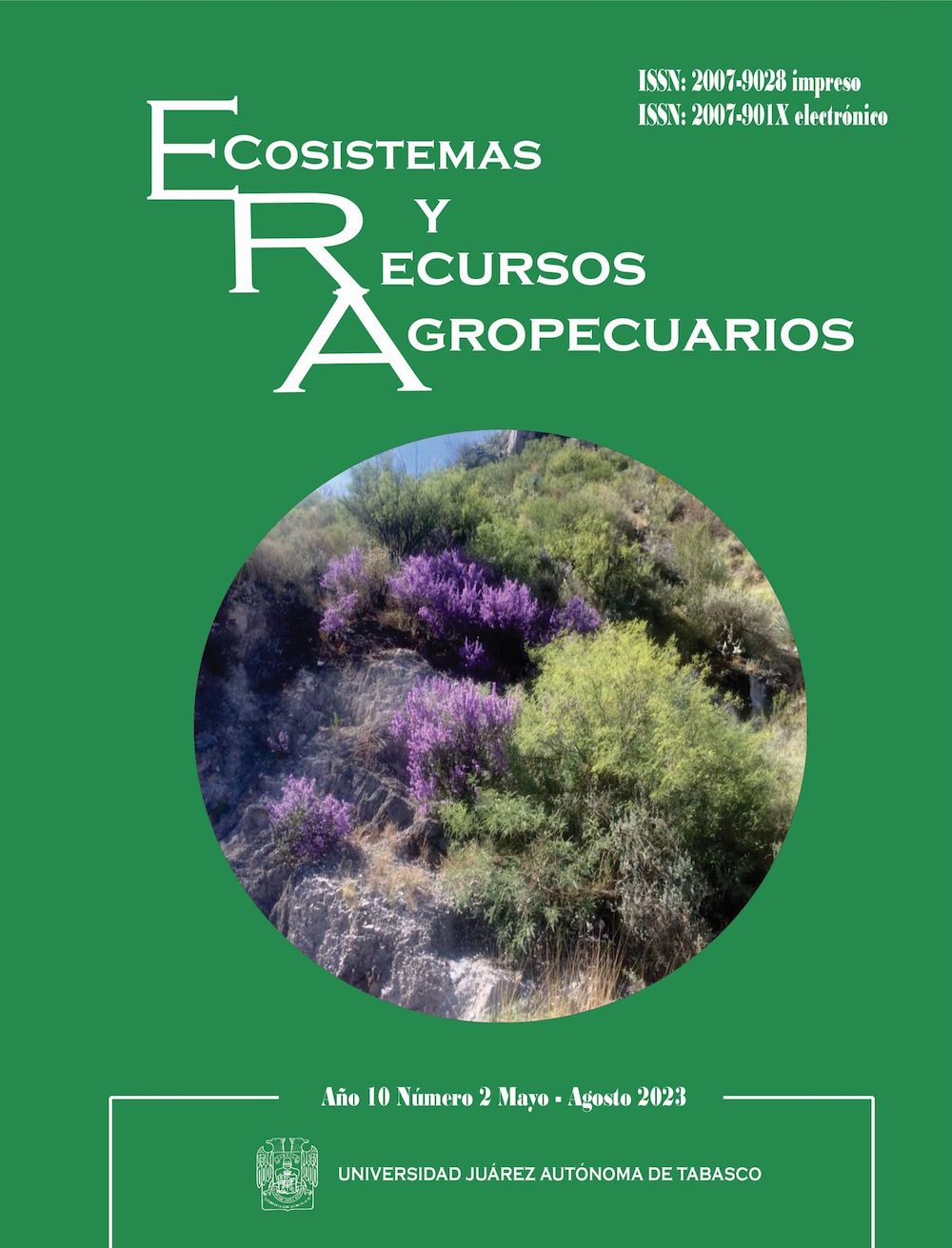Bioestimulantes en el crecimiento y rendimiento de Phaseolus vulgaris L. en el Norte de Sinaloa
DOI:
https://doi.org/10.19136/era.a10n2.3650Palabras clave:
Micorriza, aminoácidos, componentes del rendimiento, área foliar, peso secoResumen
El estado de Sinaloa, es el mayor productor de frijol (Phaseolus vulgaris L.) a nivel nacional, por lo que, se está implementando el uso de bioestimulantes para su producción, para disminuir el uso de fertilizantes químicos, y contribuir de manera amigable con el ambiente. El objetivo de este trabajo fue evaluar el efecto de la micorriza Glomus intraradices (M), aminoácidos libres (AA) y la combinación M + AA sobre el crecimiento de la parte aérea de la planta y el rendimiento y sus componentes en frijol variedad Azufrado Higuera en condiciones de campo, en el norte de Sinaloa. Se utilizó un diseño en bloques al azar con tres repeticiones: T1) AA; T2) M; T3) la combinación M + AA, y T4) control. El crecimiento de la parte aérea de la planta y el rendimiento fueron mayores con el tratamiento M + AA.
Descargas
Referencias
Anli M, Baslam M, Tahiri A, Raklami A, Symanczik S, Boutasknit A, Ait-El-Mokhtar M, Ben-Laouane R, Toubali S, Ait Rahou Y, et al. (2020) Biofertilizers as strategies to improve photosynthetic apparatus, growth, and drought stress tolerance in the date Palm. Frontiers in Plant Science 11: 516818. DOI: 10.3389/fpls.2020. 516818.
Ashwin R, Bagyaraj DJ, Raju BM (2023) Ameliorating the drought stress tolerance of a susceptible soybean cul- tivar, MAUS 2 through dual inoculation with selected rhizobia and AM fungus. Fungal Biology and Biotech- nology 10: 10. DOI: 10.1186/s40694-023-00157-y.
CEVAF (2003) Frijol. En: Guía para la asistencia técnica agrícola para el área de influencia del Campo Agrícola Experimental Valle del Fuerte. Campo Experimental Valle del Fuerte. INIFAP-CIRNO. Juan José Ríos, Agenda Técnica. Sexta edición. Sinaloa México. pp: 66-71.
Cristofano F, El-Nakhel C, Pannico A, Giordano M, Colla G, Rouphael Y (2021) Foliar and root applications of vegetal-derived protein hydrolysates differentially enhance the yield and qualitative attributes of two lettuce cultivars grown in floating system. Agronomy 11: 1194. DOI: 10.3390/agronomy11061194.
Drobek M, Frac M, Cybulska J (2019) Plant biostimulants: importance of the quality and yield of horticul- tural crops and the improvement of plant tolerance to abiotic stress-A review. Agronomy 9: 335. DOI: 10.3390/agronomy9060335.
Du-Jardin P (2015) Plant biostimulants: definition, concept, main categories and regulation. Scientia Horticulturae 196: 3-14.
Franzoni G, Cocetta G, Ferrante A (2021) Effect of glutamic acid foliar applications on lettuce under wáter stress. Physiology and Molecular Biology of Plants 27: 1059-1072.
Giordano M, El-Nakhel C, Carillo P, Colla G, Graziani G, Di Mola I, Kyriacou MC, Rouphael Y, Soteriou GA Sabatino L (2022) Plant-derived biostimulants Hidalgodifferentially modulate primary and secondary metabo- lites and improve the yield potential of red and green lettuce cultivars. Agronomy 12: 1361. DOI: 10.3390/ agronomy12061361.
Hidalgo-Rodríguez JEM, Ramos-Otiniano CC (2019) Coinoculación de Rhizophagus irregularis y Rhizobium sp. en Phaseolus vulgaris L. var. canario (Fabaceae) “frijol canario”. Arnaldoa 26: 991-1006.
Hristozkova M, Orfanoudakis M (2023) Arbuscular mycorrhiza and its influence on crop production. Agriculture 13: 925. DOI: 10.3390/agriculture13050925.
Ikan C, Ben-Laouane R, Ouhaddou R, Anli M, Boutasknit A, Lahbouki S, Benchakour A, Jaouad A, Bouchdoug M, El-Moatasime A, et al. (2023) Interactions between arbuscular mycorrhizal fungus and indigenous compost improve salt stress tolerance in wheat (Triticum durum). South African Journal of Botany 158: 417-428
INIFAP (2022) Instituto Nacional de Investigaciones Forestales, Agrícolas y Pecuarias. https://clima.inifap.gob.mx/ lnmysr/DatosIndirectos/EMV. Fecha de consulta: 20 de diciembre de 2022.
Ismail AY, Fayed AAM (2020) Response of dry seed yield of Faba bean “Vicia Faba, L.” to spraying with amino acids, organic acids, (NAA) growth regulator and micro nutrients. Alexandria Journal of Agricultural Sciences 65: 7-16.
Kocira A, Lamorska J, Kornas R, Nowosad N, Tomaszewska M, Leszczynska D, Kozowicz K, Tabor S (2020) Changes in biochemistry and yield in response to biostimulants applied in bean (Phaseolus vulgaris L.). Agronomy 10: 189. DOI: 10.3390/agronomy10020189.
Lara-Acosta D, Costales-Menéndez D, Nápoles-García MC, Falcón-Rodríguez A (2019) Pectimorf® y Azofert-F® en el crecimiento de
plantas de frijol (Phaseolus vulgaris L.). Cultivos Tropicales 40: e05.
Ojuederie O, Olanrewaju O, Babalola O (2019) Plant growth promoting rhizobacterial mitigation of drought stress in crop plants: implications for sustainable agriculture. Agronomy 9: 712. DOI: 0.3390/agronomy9110712.
Peña CC, Rodríguez JC, Olivera D, León-Orellana N, Lugones Y (2017) Efecto de un promotor del crecimiento en el comportamiento productivo del frijol (Phaseolus vulgaris L.). Avances en Investigación Agropecuaria 21: 35-45.
Petropoulos SA, Fernandes A, Plexida S, Chrysargyris A, Tzortzakis N, Barreira JCM, Barros L, Ferreira ICFR (2020) Biostimulants application alleviates water stress efects on yield and chemical composition of green- house green bean (Phaseolus vulgaris L.). Agronomy 10: 181. DOI: 10.3390/agronomy10020181.
Refaay DA, El-Marzoki EM, Abdel-Hamid MI, Haroun SA (2021) Effect of foliar application with Chlorella vulgaris, Tetradesmus dimorphus, and Arthrospira platensis as biostimulants for common bean. Journal of Applied Phycology 33: 3807-3815.
Romero-Félix CS, López-Castañeda C, Kohashi-Shibata J, Martínez-Rueda CG, Miranda-Colín S, Aguilar-Rincón VH (2021) Rendimiento y biomasa acumulada en frijol común bajo riego y secano. Revista Mexicana de Ciencias Agrícolas 12: 1363-1376.
Rouphael Y, Colla G (2020) Toward a sustainable agriculture through plant biostimulants: from experimental data to practical applications. Agronomy 10: 1461. DOI: 10.3390/agronomy10101461.
Salinas-Pérez RA, Rodríguez-Cota FG, Navarro-Sandoval FJ, Padilla-Valenzuela I (1995) Nuevas variedades de frijol para Sinaloa. Sinaloa, México. Folleto Técnico Núm.11. Instituto Nacional de Investigaciones Forestales, Agrícolas y Pecuarias. 12p.
Sánchez-Roque Y, Pérez-Luna YC, Santos-Espinoza AM, Gutiérrez-Miceli FA (2022) Evaluation of the effect of native arbuscular mycorrhizal fungi an vermicompost leachate on the yield and quality of field-grown peanuts. Terra Latinoamericana 40: e1612. DOI: 10.28940/terra.v40i0.1612.
Shahrajabian, MH, Cheng Q, Sun W (2022) The effects of amino acids, phenols and protein hydrolysates as biostimulants on sustainable crop production and alleviated stress. Recent Patents on Biotechnology 16: 319-328.
Shapiro SS, Wilk MB (1985) An analysis of variance test for normality (complete samples). Biometrika 52: 591- 611.
SIAP (2022) Servicio de Información Agroalimentaria y Pesquera. https://nube.siap.gob.mx/cierreagricola/. Fecha de consulta: 21 de noviembre de 2022.
Szpunar KE (2022) Physiological response of pea (Pisum sativum L.) plants to foliar application of biostimulants. Agronomy 12: 3189. DOI: 10.3390/agronomy12123189.
Tamayo-Aguilar Y, Juárez-López P, Capdevila-Bueno W, Lescaille-Acosta J, Terry-Alfonso E (2020) Bioproductos en el crecimiento y rendimiento de Phaseolus vulgaris L. var. Delicia 364. Terra Latinoamericana Número Especial 38: 667-678.
Valero VNO, Chima MKA, Gómez GJA (2023) Efecto bioestimulante de una chalcona sintética sobre el frijol guajiro (Vigna unguiculata L. Walp). Revista Biotecnología en el Sector Agropecuario y Agroindustrial 21(2): 1-15.
Publicado
Número
Sección
Licencia
Derechos de autor 2023 Ecosistemas y Recursos Agropecuarios

Esta obra está bajo una licencia internacional Creative Commons Atribución-NoComercial-CompartirIgual 4.0.
1. Política propuesta para revistas de acceso abierto
Los autores/as que publiquen en esta revista aceptan las siguientes condiciones:
1. Los autores/as conservan los derechos de autor y ceden a la revista el derecho de la primera publicación, con el trabajo registrado con la Licencia CC BY-NC-ND 4.0 Creative Commons Attribution-NonCommercial-NoDerivatives 4.0 Internacional de Creative Commons, que permite a terceros utilizar lo publicado siempre que mencionen la autoría del trabajo y a la primera publicación en esta revista.
2. Los autores/as pueden realizar otros acuerdos contractuales independientes y adicionales para la distribución no exclusiva de la versión del artículo publicado en esta revista (p. ej., incluirlo en un repositorio institucional o publicarlo en un libro) siempre que indiquen claramente que el trabajo se publicó por primera vez en esta revista.
3. Se permite y recomienda a los autores/as a publicar su trabajo en Internet (por ejemplo en páginas institucionales o personales) antes y durante el proceso de revisión y publicación, ya que puede conducir a intercambios productivos y a una mayor y más rápida difusión del trabajo publicado (vea The Effect of Open Access).
![]()
This work is licensed under CC BY-NC-ND 4.0


